#Great Palm Civet
Explore tagged Tumblr posts
Text
technically I have dog time once a week but you don't see me post cute dog pictures every week because sometimes you go in and all the dogs are cute and everything is great and sometimes the boys go feral and try to rip each other to pieces and sometimes you find a halfeaten disembodied animal tail in the grass. such are the ups and downs of dog life
#once found an entire mummified pigeon under a cage like what're you gonna do#anyway rip to what was most likely a masked palm civet you probably made a great chew toy#the ho rambles#animal death
7 notes
·
View notes
Text
JTTW Chapter 1 Thoughts
I finally managed to sit myself down and read the first chapter for the @journeythroughjourneytothewest Reading Group!
So I have actually decided on dual-reading each chapter. As I have a physical copy of Anthony C. Yu’s translation I read that one first, though afterwards I looked at the J.F. Jenner translation as well, which ultimately made me come to the decision of reading both versions each chapter. While Anthony C. Yu's version has more definitive detail, J.F. Jenner's is just easier to understand. It is very much a sense of I kind of got it the first read including the major points, but I really connected some additional dots with the second.
Additionally I'll be listening to the Audio Drama Series on YouTube by @jttwaudiodrama, the chapters that are available so far anyway, which honestly might be my personal favourite already. I adore that they use the Mandarin names at least once when they come up for the first time and they use the original measurements and such! It was so weird reading "36 feet and 5 inches", partially because I use the metric system, meanwhile “3 Zhang 6 Chi and 5 Cun” felt far more natural to hear. The Production Notes for each chapter are great too!
Now onto some of the thoughts that came up in my mind while reading!
“It’s free real estate.” When the monkeys were moving into Shuilian Cave that’s what immediately entered my mind.
Also something I found interesting is that the stone mansion was abandoned seemingly in a somewhat hasty manner? At least that’s how it came across to me with it not being completely clean, but there still being leftovers on the table. That or the previous owner didn’t care much for keeping things orderly, it could be either really.
Very much love the anti-grindset vibes when Sun Wukong sees how focused on fortune and fame humans are always striving for more. They are practically working themselves to death without ever stopping to just live in the moment for a while and are never satisfied with what they have either. One ought to think if you are already a prime minister as mentioned in the poem you have more than enough wealth to live comfortably.
One could argue that since they believe in reincarnation, which might even be a confirmed fact there, they might think they will be able to relax in another life. However when would that life come around then, if they just continue with this work ethic lifetime after lifetime? If they simply want their children to have a comfortable life, why would they be perpetuating this mindset actively preventing them from having one?
Then you have the woodcutter as the exception to the rule, who doesn't have much, but is still rather content outside of genuinely valid concerns regarding getting enough food on the table.
This whole issue being brought up so early in the book already puts it in a very good light. Looking forward to the story's further exploration of these topics!
Rounding out with something sweet, one of the animals Sun Wukong befriends in the Anthony C. Yu translation is a civet, which I didn’t know what it was, so I looked it up. They are so adorable! Just look at their big ol’ eyes and cute little snoot! Precious!

This is an Asian Palm Civet specifically, which I guess might be the kind he could have met. Something I read on African Civets specifically, which I assume goes for other kinds of civets as well to some extend at least, is that they are not felines which one might guess at first glance. They are more closely related to weasels or mongooses instead!
36 notes
·
View notes
Note
You’ve probably gone over this before but tumblr’s search engine sucks butt. So, what would each culture’s staple crops and livestock (for both meat and byproducts) be? How much would globalization come into play, like how irl potatoes are originally from South America but have become one of the most important staple foods across the world?
Staple crops and livestock vary throughout the Provinces due to climate and geography, though trade over the centuries has meant that ingredients like saltrice from Morrowind and honey from Skyrim are in constant circulation around the continent. Nonetheless, here are some uniquely local ingredients you'll find across Tamriel.
Altmer
Summerset's temperate climate makes it the ideal place to grow all sorts of exotic fruit, especially stone fruit. From peaches to lychees, nectarines to cherries, Summerset produces the largest quantities of these fruits (with the trade embargo around the Great War and Dragon Crisis making them an extremely sought-after prize). And don't forget the wine! Summerset is also famed for its gorgeous vineyards and even more gorgeous wines. However, juicy and flavourful grapes are beloved by almost anybody, making them a valuable staple crop too.
Livestock in Summerset is nothing particularly exciting. Merino sheep are farmed for their wool, which is a luxury export beloved by northern Provinces, while meat comes in the form of cattle and chickens. However, High Elves particularly love their wild-caught fish and herons, which are populous on their home island.
Argonians
Once again, fruit is a major export from Black Marsh, but the fertile (if hostile) region is home to some of Tamriel's best agricultural soil. From cocoa and coffee beans, saltrice and coconuts, to padan and banana leaves and more, you'll find all sorts of wonderful plant-based ingredients in Black Marsh. However, something that has gained in popularity following the Argonian diaspora has been palm wine, a potent alcoholic beverage.
As for livestock, you'll find bantam guar, guar lizards, various poultry, goats, and even farmed frogs and lizards to be popular. Sheep and cattle are far less popular due to the upkeep required for them to stay healthy in the swampy environment, making beef and mutton less popular and more expensive than in other Provinces.
Bosmer
The Bosmer are famed for their meat and animal byproducts, particularly from timber mammoths and sugar mammoths. Whether it's meat, pelts, or milk, these beasts are much beloved by the Wood Elves who take great care in rearing them.
Other popular exports from Valenwood include alcoholic beverages like rotmeth and jagga, as well as kopi luwak- a luxurious type of coffee made from beans found in civet cat excrement, thus making them Green Pact-friendly. And of course, Valenwood produces some of Tamriel's finest cocoa beans, mostly used for export. However, have you truly lived until you've tried salted sugar mammoth caramelised milk chocolate from Woodhearth?
Bretons
In High Rock, sheep and cattle are the most popular livestock to farm due to their versatility, with a constant demand for their meat, horns, skins, and milk. While it's nothing exciting, the animals in the region are usually grass-fed and free range, spanning acres of farmland (which can sometimes result in cultists and the like infringing upon the livelihood of livestock). Chickens, geese, turkeys, and ducks are also popular for their meat, down, and eggs, with High Rock producing some of Tamriel's best duck meat.
With regards to staple crops, wheat is a major export and features heavily in Breton cuisine, especially in bread.
Dunmer
The volcanic ash of Morrowind is key to its success in growing all manner of weird and wonderful crops. Market stalls across Vvardenfell and Blacklight bustle with sellers touting mushrooms of all kinds, saltrice, comberry, marshmerrow, hackle-lo, canis root, and much more, all of which are consumed locally as well as across Tamriel.
Regarding livestock, it should come as no surprise that the big money is in bug farming. Kwama mines produce cuttle, scuttle, scrib jelly, and kwama eggs, making them the backbone of Morrowind's mages and chefs alike. Nix-hounds and guar are raised both by town Dunmer and Ashlanders, while wild nix-ox is also popular for those who can afford it.
Imperials
Cyrodiil spans terrain from the snowy Jerall Mountains to the swamps of Blackwood. As a result, the Province is relatively self-sufficient in that it produces the bulk of its own consumption, from livestock to greens. Speaking of greens, battaglir, a type of weed, is a staple in the Imperial diet, making wild-foraged and farmed battaglir a key crop in the region. Like Summerset, Cyrodiil is also famed for itswines, and is proud of its unique grapes of every size, flavour, and colour (including ones that taste like cotton candy).
Livestock in Cyrodiil is about as generic as can be: cows, sheep, goats, poultry, and horses. While meat is a staple part of the Imperial diet, milk is also important as it is used to make the cream and cheeses so prized by the Province.
Khajiit
What don't the Khajiit grow or rear? From Southern Elsweyr's rich moon sugar and rice paddies to the North's edible cacti and tea, the Province is full of exotic and scrumptious delights that are highly prized across Tamriel. Ingredients are valuable both raw and processed, and form the backbone of the Khajiiti economy. Samar Pekoe tea, for example, is wild-harvested from caves and is beloved by tea aficionados across the continent, and fetches a hefty price for its rarity. Pellitine cacao and coffee beans are also a staple in any self-respecting chef's kitchen.
In terms of livestock, you'll find guar, poultry, beef, and goat to be popular, as well as wild game like jerboas, terror birds, antelope, and addaxes. Game meat can often be purchased from Bandaari nomads, who hunt the animals themselves. Whether fresh or dried into jerky, who doesn't want some moon sugar-cured addax jerky for the road?
Nords
Foreigners in Skyrim are often shocked by the range of produce we're capable of producing in our cold and often inhospitable lands. Fish and horker are consumed in great amounts locally, as well as being one of the Province's major exports. Goat from the Reach, cattle from Whiterun, and honey from the Rift are always in high demand.
Apples and jazbay grapes are probably the most valuable crops in Skyrim, followed by wheat and other fruits and vegetables. The former two are used in cider and wine, both of which are valued across the Provinces.
Orcs
Wrothgarian Orcs differ from Betnikh Orcs who differ from Wood Orcs and so on... so in this case, it really varies. For Wrothgarian Orsimer, echatere is the main source of meat and milk, while in Betnikh it's fish, and in Valenwood, timber mammoth. All these groups also enjoy game, from rabbit and wolf to pheasant and venison, which features heavily in regional Orcish cuisine. Wild honey from Betnikh is also another notable animal product that bears mention here.
In terms of crops, there aren't many of note aside from valuable herbs and spices. Frost mirriam, which is also loved by alchemists, and wrathberries, known for their violently bitter taste unless prepared correctly, are two of the most important plants you'll find for sale at any stronghold.
Redguards
I've said it before and I'll say it again: goat, goat, and more goat. Unless you're a coastal Redguard with access to seafood, it's likely that your main source of meat and milk will come from goats. Whether it's feta or kebabs, it's almost always goat meat, as they wander all through Hammerfell like they own the place. However, Redguards are also renowned for breeding horses, and the uh... faulty ones are generally turned into food. Spiced horse blood sausage and spreadable horse 'nduja are a staple in households across Hammerfell.
With staple crops, you'll find that corn, coconuts, palm fruit and oil, bananas, coffee, cinnamon and other spices, and cocoa are plentiful. These are all consumed in great amounts within the Province, but are also highly prized across Tamriel.
77 notes
·
View notes
Text
From now on, we will list the normal types.

NORMAL pure
Gibbon characterized as an opera singer.
Snake looking like a rope, tied in a knot.
Scared chicken, releasing its feathers to escape the predator.
Lizard that stretches its trunk, evolving into a more serpentine reptile.
Fish evolving and adapting to live on land into a mammal-like creature.
Coati with Groncho Marx disguise, uses the tail as a wig.
Hedgehog nurse, responsible for stitching wounds.
Hybrid of hare and tortoise, having the speed of the first and the protection of the second.
Civet with a slender body and skill in contortionism.
NORMAL/GROUND
Sandfish lizard looking like a walking fish.
Pig-nosed snake with X in its eyes, appearing to be crushed.
Puppy capable of sniffing bones and finding fossils.
Weasel or ferret that crawls on the ground like a snake.
Armadillo helping with construction work, its shell looks like a construction worker's helmet.
Mud pig with a vegetable garden on its back.
Cute-looking creature that lives in a bucket of sand.
Creature lying face down on the floor, looking like a dirty carpet.
Oyster chest keeping smaller shells inside.
NORMAL/GRASS
Mouse with petals on its head that it covers to hide its face.
Wooden alligator, camouflaged as a branch or log.
Lettuce creature, using its leaves to fan.
Straw scarecrow, made to take care of farms.
Instrumental mushrooms, making drum noises.
Eggplant chicken laying eggfruits.
Snake of medicinal herbs, inside a bottle of liquid, creating medicine.
Palm tree standing still during the day and walking at night.
Fox with a fluffy, colorful tail made of ornamental grass.
NORMAL/ICE
"Hairy" trout adapted its scales to look like hair and protect it from the cold.
Snow monster that creates huge ice balls.
Fox can slow down its heartbeat and survive frozen.
Lemming coming out of the snow like in the whack-a-mole game.
Polar anteater, predator of vanilittes, with a long tongue.
Creature transforming its voice into freezing waves.
Seal that lives in mountains, sliding down them like a sled.
Frog surviving inside a huge ice cube.
Animal covered by a skin that covers it, looking like a blanket.

NORMAL/FLYING
Bat singing melodies and even replacing route birds.
Animal with a long tail that turns it like a propeller.
Woodpecker sticking out his pointed tongue to hurt his opponent.
Bird with feathers on its head that look like a huge hat.
Wind elemental antelope, being blown as if leaping into the air.
Bittern imitating a strange monster to scare enemies.
Critter jumping from great heights; uses its skin as a parachute.
Collared lizard using its umbrella membrane to be carried by the wind.
Flying lemur looking like a hang glider when flying.
NORMAL/ROCK
Pet rock, actually a turtle hibernating in its shell.
Hirax carrying rocks with its large tusks.
Small compsognathus, the route "bird" of its time.
Sculptor-themed "Smeargle", with a chisel tail.
War horse made of stone, very resistant.
Mouse breaking rocks with its drill teeth.
Lizard with stone spines, can inflate itself like a blowfish.
Little monster juggling stones and being able to throw them.
Female Pokémon that is decorated with shiny jewelry.
NORMAL/WATER
Small toy dinosaur, absorbs water to grow.
Axolotl with spots resembling bandages on its body; it regenerates quickly.
Fire-type predator aquatic snake, resembling a hose.
Catfish making noises like a real cat.
Swimming Pokémon with inflatable organs to float.
Cetacean spraying explosive bubbles from the vent.
Literal frogman looking for sunken objects.
Fish that imitates a rubber duck.
Tambaqui very docile, appearing to behave like a dog.
NORMAL/STEEL
Goat with horns looking like saws.
Mechanical ballerina that plays music, like a music box.
Pig made of melted coins, sniffs metal.
Mouse with a tail like a key, looking like a toy.
Gerenuk with a neck covered in golden rings.
Small beings that help with construction and repairs, based on tools.
Snake with a spring body, moves by jumping and traps the victim by wrapping itself around it.
Gourmet Pokémon with cutlery limbs.
Creature with an organ like microphone that amplifies its sounds.

NORMAL/FIGHTING
Sheep using their wool as muscle padding.
Hunting dog with its attacks based on its large jaw.
Cartoon animal with elasticity and resistance abilities.
Fighter capable of inflating himself like a balloon and repelling physical attacks.
Breakdance dancer capable of rotating his body and limbs.
Greco-Roman wrestling turtle, pinning the opponent to the ground.
Monster carrying objects and throwing them at others.
Duck with wings shaped like boxing gloves, but soft as pillows.
NORMAL/FIRE
Animal with a flaming tail that it uses as a torch.
Turkey that breathes fire, warmed by its plumage.
Fire-breathing llama, warm with its wool.
Flaming chameleon with color changing fire.
Tapir sneezing fire after being exposed to the sun.
Lizard swallowing eggs and frying them in its throat.
Pie monster attracting prey with its scent.
Goat that breathes fire, predators of scorvillain, counterpart of the polar anteater.
Dancing mouse using matches as sticks.

NORMAL/ELECTRIC
Animal from very dark forests, can glow in the dark.
Lizard glowing in the dark to attract insects.
Furry animal using static from its fur to group together.
Dolphin used by sailors as radar.
Rabbit with pointy ears resembling tasers.
Pikaclone house mouse using its socket tail to steal energy.
Monkey that climbs electrical wires, helps electricians.
Reideer using its antlers to light paths at night.
Dinosaur toy that runs on batteries to gain energy.
FINAL LEGENDARY:
Mythological pure normal farm animal that fed the hungry in hard times.
Normal pokémon list completed.
3 notes
·
View notes
Note
It was getting late in the day when another gift for Kaoru arrived. After being forced by Yuriko to fix the backyard after the fiasco with the giant robot she had been gifted earlier, the birthday girl sighed as she collapsed in her chair in her lab, exhausted.
"Being forced to do labor on my own birthday." Kaoru complained, upset. "There should be a federal law against that sort of thing."
Sighing again, the girl turned to her computer, prepared to log back into the Web. Reaching out, her hand instinctively grabbed a cup of coffee and brought it to her mouth... only to be disappointed when she realized that it was empty.
"Ugh, great." Kaoru complained, realizing she'd have to head to the kitchen to grab some more coffee. Sighing once more, the hacker girl got out of her seat and opened the door... only to find Kanra on the other side of it, surprising the both of them.
"Kanra?" Kaoru questioned.
"Wow, nice intuition." Kanra complimented. "How'd you know I was about to knock on the door?"
"...I didn't." Kaoru answered, cocking an eyebrow. "I was about to head to the kitchen to get some coffee. What's up?"
Instead of answering, Kanra held up a small gift box in her left hand.
"This is for you. It's from Elliot-kun."
Raising her eyebrows at the gift, Kaoru took it from her younger sister. Feeling it, it was pretty light, though there was obviously something inside. Unwrapping, both sisters looked inside.

Inside was a plate filled with what looked like beans. Both girls cocked an eyebrow at it, confused.
"...What is that?" Kanra asked.
"You got me." Kaoru answered, lifting the plate out of the box, careful not to drop the beans on it. As she lifted it up, she noticed a note in the box. Picking it up, she looked as it read:
"Happy birthday, Kaoru-san. Sorry for delivering this gift so late, but I got stuck with work at the vet. By the time I got home, it was already late. Anyway, I know you're probably wondering what these beans are. They're Kopi Luwak beans. I may have mentioned them before, but basically, they're used to make a really good blend of coffee! I drink it every morning thanks to Goemon, my pet palm civet. I know you like coffee as much as I do, so I sent these to you. I don't know if you've tried Kopi Luwak coffee before, but it's really good! At least, I think so. I really hope you like it! And happy birthday again."
Signed,
Elliot
“Kopi Luwak?” Kanra questioned the foreign words, not ringing a bell to her.
“Oh! It’s those things!” Kaoru snapped her fingers, finally remembering where she knew that name.
“What are they?”
“There are certain types of coffee beans that go through a process of having an animal eat it, go through its intestines, and where harvesters pick it up and clean it. In this case, the animal is the Asian Palm Civet. It’s very expensive.” Kaoru explained to Kanra, who just stared at Kaoru blankly.
“So…it’s poop coffee.”
“Oh my...they wash them before they sell the damn things, Kanra.”
“Okay but it still was in the poop!”
Just when the two were about to start arguing, a hand reached out and grabbed the plate. It was A.D.A who now held the plate above her head.
“No fighting you two. Yuriko is still angry from earlier. Do you really want to anger her even more?” A.D.A tapping her foot on the ground. Seeing the two shake their heads no, she smiled.
“Good. Now Kaoru, you haven’t slept in almost 200 hours, and you already had 12 cups of coffee today. So no more I'm cutting you off. You can try this tomorrow.” A.D.A ordered and walked away carrying the plate with her.
“A.D.A! Come on! One Sip!”
#hypnosis microphone#hypnosis mic#hypmic#hypmic oc#hypnosis mic oc#shinozaki kaoru#akemi kanra#a.d.a#ageha shinozaki#elliot shimizu#palenightmarefestival#happy birthday kaoru 2024
5 notes
·
View notes
Note
Michinaga: Oi, where are the
Satonaka: *shoots the Birth Blaster but is having no effect,*
Michinaga: Is that all?
Satona: *continues shooting*
Hina: *has the biggest shovel and bats Buffa to the sky*
Chiyoko: That takes care of that.
Chiyoko: We already lost someone once and we’re damn sure not going to let someone take it away again.
Gotou: Sometimes I think if the girls should have their own Rider suits.
Eiji: Wouldn’t that be great?
DatE: It would until they use them against you.
Hina: What did you say boys?
Gotou: NOTHING!
Honestly, Hina could probably stop Azuma rampaging by grabbing him by the horns and yeeting him herself XD Azuma won't even know what hit him... or rather, what didn't hit him.
Woe be to the Riders if Hina ever teaches her secrets to the resident kitty, palm civet and navigator :))
And yes, Chiyoko and Hina absolutely deserve their own Rider forms
Also, what do you mean by they lost someone? Eiji and Ankh are just off adventuring in Africa :)) They better come back for a visit soon or Akane will be very upset with her nii-chan and Ankh-chan
#kamen rider ooo#kamen rider geats#michinaga azuma#shiraishi chiyoko#izumi hina#yeet the bull into a ditch :))#ask#cloudaintfair-archive
10 notes
·
View notes
Text
Civets as well a Genets are very fascinating, adorable creatures. Genets actually make good pets. These animals are feline-like in appearance, either carnivorous or omnivorous, but are not related to actual felines. They are nocturnal and rest in tress, rock crevices, and empty burrows. Civets and Genets are usually solitary.
“The vocal African palm civet spends most of it’s time the forest canopy, where it feeds chiefly on the fruits of trees and vines and occasionally on small animals and birds. All other species of pine civets are confined to the forests of Asia. They are skillful climbers, aided by their sharp, curved, retractable claws, usually naked soles, and partly fused third and fourth toe, which strengthen the grasp of the hindfeet” (Mcdonald pg. 124).
The fossa is a species of Civet that is found only in Madagascar. They have long tails which help with climbing as well as keeping their balance when hunting in the treetops. They look a lot like a big cat. They take up the niches that lions, tigers, or other feline apex predators would because there are no feline species native to the island. They are much closer related to mongooses than actual felines. Even so, they have retractable claws, akin to those of a feline. They can potentially grow up to six feet long and weigh 26 pounds.
Sulawesis or Great or Brown palm civets have webbed, flexible feet. In Southeast Asian forests, there are five species of banded palm civets and otter civets. Banded palm civets eat lizards, frogs, rats, crabs, snails, earthworms, and ants. Owson’s banded civet mainly eats invertebrates. Hose’s palm resembles the banded palm civet in body but has a differing head shape. Otter civets have shorter rounded ears, a thinner pointier muzzle, a more compact body, and a shorter tail. African civets live in all habitats on the continent. Indian civets are smaller than Indian civets and eat small mammals and birds, stalking prey like a cat. They also scavenge and eat eggs.
Binturongs or bearcats have been reported to swim in rivers and catch fish. They resemble a combination of bears and cats but are not ursine or feline. Their long, fluffy tails sometimes serve as a fifth hand. They can potentially live up to 20 years. They are found in forests throughout Southeast Asia. Unfortunately, they are a vulnerable species due to habitat destruction.
Binturongs are thought to be the most closely related to palm civets. They are generally solitary and nocturnal, like most civets. They are generally shy animals, and hard to spot, especially due to their endangered status. The habitat loss has been worse in the southern range of territory. They rely on thick, dense forests for shelter and safety.
#Civets#Mammal Encylopedia#Genets#David Macdonald#African Pine Civet#Madagascar#Fossa#Southeast Asia#Binturong#Bearcat#Sulawesi#Great Palm Civet#Brown Palm Civet#Banded palm civet#Owson's banded civet#Hose's palm civet#Otter civets#African civets#Indian Civets
3 notes
·
View notes
Photo

Nandinia binotata - African Palm Civet
#african palm civet#civet#nandinia#binotata#nandiniidae#carnivora#mammalia#chordata#animalia#least concern#africa#african rain forest#swahili coast#congo river basin#african great lakes#southern africa#terrestrial#forest#rain forest#the faunal frontier#thefaunalfrontier
96 notes
·
View notes
Text
Tansy Refsheet
I finally finished making a highly professional refsheet for Tansy, my little regenerating immortal critter of dubious origin!
I’m by no means a good visual artist but this at least conveys a basic idea of what she looks like. You can also find this on my DeviantArt page at https://www.deviantart.com/ihcfanfic/art/Tansy-Refsheet-888217938
Tagging @just-a-whumping-racoon-with-wifi because I think you said she sounded cute when I mentioned her in an ask so I thought you might want to see what she looks like.

Other Info:
Her design is based off martens, genets, and ringtails. This is kind of the “default” body plan for carnivorans, though. I’m not sure where Tansy would fit into Feliformia or Caniformia - if she has relatives they might actually be something that diverged before the feliform-caniform split, like a surviving Miacid lineage - which would technically put them outside of Carnivora.
Tansy’s body is long, slender, and flexible - think martens or genets. She’s not quite as noodley as a weasel or ferret but still kind of in the “Noodle-cat” category. The fur makes her look a bit less skinny than she actually is. She’s pretty lightly built, made for agility and flexibility, not strength. This is a bit deceptive though, because she’s unusually strong for something her size.
She only weighs about 5-6 lb on a good day, which is comparable to a really small domestic cat, but a little bigger than polecats, ferrets, or martens.
Tansy’s fur is kind of similar in texture to a cat’s: it’s fine and silky, and can be pretty warm when it’s all fluffed up, but it doesn’t repel water very well and can easily be saturated by heavy rain or immersion in water. I don’t think she likes the British climate very much!
Her paws are kind of half-digitigrade, half-plantigrade. She normally walks and runs in a digitigrade stance but can drop into a plantigrade one when climbing or trying to stay low to the ground. Often she has her entire front paw on the ground while still walking on the toes of her back paws. There are quite a few animals like this, including martens, ringtails, and fossa.
Her back paws don’t have a full “sole” like a fossa, civet, or genet, but they do have a small “tarsal pad” on the heel.
Her forepaws are kind of halfway between the paws of a ringtail or pine marten and a raccoon’s hand. Again there isn’t a full palm or bare skin along the entire length of the finger, but she has elongated fingers without skin webbing between them, which gives her a lot of manual dexterity. Her front paws do have a bit more fur than a raccoon’s which kind of masks how hand-like they are.
Tansy has five digits on all four paws - not four like a dog or cat! The fifth toe touches the ground even in digitigrade stance, and the distal paw pad has an extra lobe at the base of it - look at the paws of martens, fishers, or ringtails for reference!
Her claws are semi-rectractile, a trait she shares with cheetahs, martens, and ringtails. They don’t fold up out of sight like most cats’ claws, but she can hold them off the ground to avoid blunting them (or making clicking noises on hard surfaces). The claws are sharp and hooked, making them excellent for climbing as well as restraining prey.
Tansy has a dark mask around her eyes, but it’s a very different shape to a raccoon’s mask. The markings don’t meet in the middle, and merge with kind of crescent-shaped markings on her muzzle similar to what genets and ringtails have. Two thin stripes go up over her forehead, and there’s also two lines going out from the corners of her eyes - a little like the marks around a Margay’s eyes if you took away the smaller spots.
The ears are kind of a weird shape and I don’t know of any real animal off the top of my head that quite matches them. Fennec foxes and some kangaroo and rabbit ears come close. Deer ears have a similar outline but Tansy’s don’t fold into a tube shape at the base. Her ears give her excellent directional hearing and are great at dissipating excess heat... but not so great in the cold.
7 notes
·
View notes
Photo
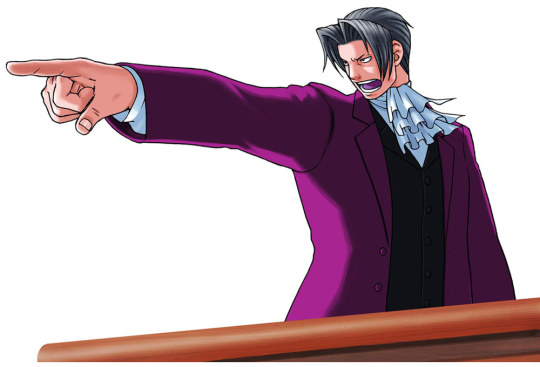


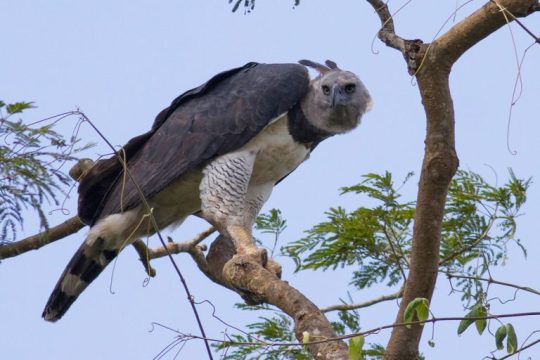

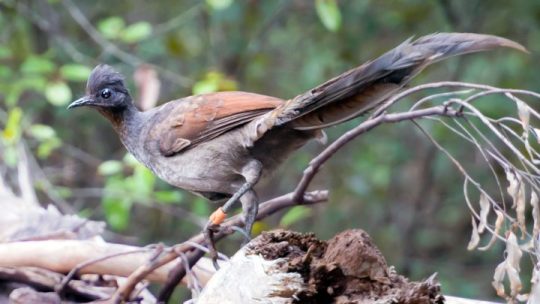

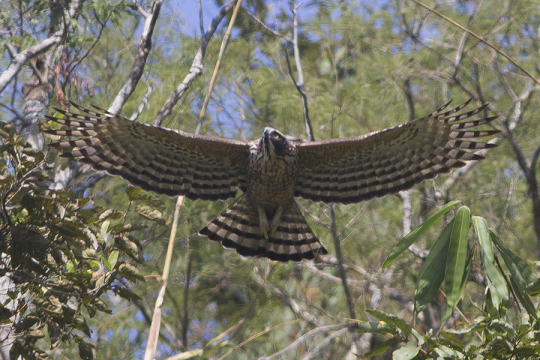

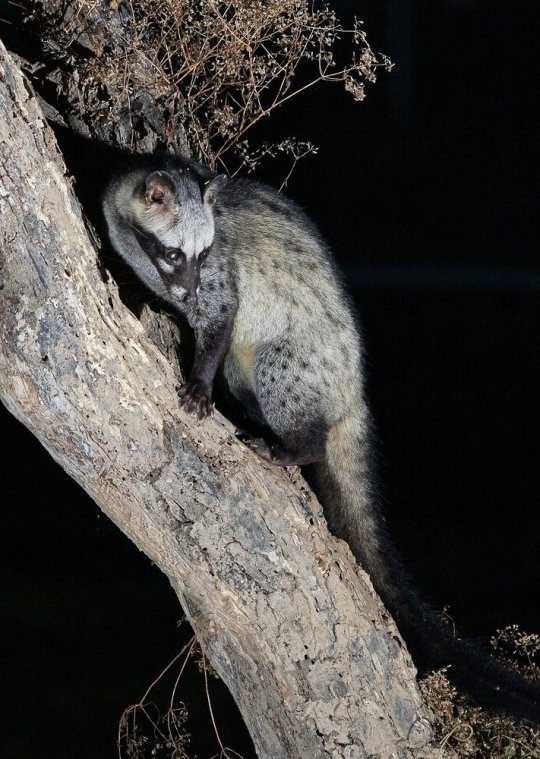
Ace Attorney Daemons - Prosecutors
Animal species and reasoning behind each choice under the cut, as well as links to other groups of characters!
Miles Edgeworth - Great Pyrenees. I originally started looking at big white dogs because I wanted to see if something similar to Pess would be suitable, and I think I found one. This breed is big and fluffy, which frankly I think would be needed for Miles growing up with the von Karmas. But honestly, his daemon is intelligent and powerful. Generally calm, but capable of leaping into swift action. However, it is at the same time at heart a protector (of livestock, traditionally) more than a predator. I think his daemon settling in this form when he is a teen would be a great way to illustrate his true nature, underneath all the Demon Prosecutor stuff (I expect he and she would be at odds for a while). Additional details I like are that these guys do tend to be more reserved with strangers and can be somewhat stubborn, and also they do shed a fair bit. I just enjoy the image of Miles having to constantly brush his gigantic floofball of a daemon and lintroller all her fur off his suits. A final thing, which I didn’t really intentionally plan, is that all prosecutors have bird daemons except Godot, who used to be a defense attorney, and Miles. So he stands out a little bit there, which I think works well too - he would be all the more determined to prove himself as Bratworth once his daemon settled in a form atypical for the profession.
Franziska von Karma - Harpy eagle. I put Manfred in the villains list since there’s no space for more prosecutors here, but it just seemed fitting to me that von Karmas typically settle as eagles. They are sharp-eyed predators, generally solitary, and look incredibly fierce, just in general. As for the harpy eagle in particular - they are huge, first of all; their claws are the same length as brown bears’. They are among the largest eagles in the world, and sometimes considered the most powerful. This seems only right for Franziska. They mostly eat monkeys, but can go after pretty much anything as they are at the top of their food chain. They can fly nearly straight up and turn their head upside down, and wait nearly a full day to snatch their prey. Franziska too is maneuverable and ridiculously determined. The head-feathers you can see slightly lifted in the photo are pretty cool, too; they rise up into a distinctive crest when the eagle feels threatened, and it actually looks a bit derpy. Which reminds me somehow of Franziska’s scornful “fool” name-calling and how it can often get to the level of absurdity. They are monogamous and fiercely protective parents, which I think can be a nice match to how Franziska really isn’t so heartless after all. And another detail that fits really nicely with her initial rivalry for Miles is that harpy eagles usually lay two eggs, but typically only the first-hatched survives. The other is ignored or even killed by its older sibling.
Klavier Gavin - Superb lyrebird. Female lyrebirds don’t look nearly as impressive as the males, and they don’t do the dramatic dances either. But they are still incredible vocalists, able to imitate sounds from at least 19 other species. And their songs tend to be mostly used during foraging and defending their nest, as opposed to attracting a mate. Obviously Klavier needs a songbird for his daemon, but I think the female lyrebird specifically is great because of those details. Her less exciting (though still pretty) plumage might not match his outer image, but he is one of the best prosecutors of the series, dedicated to the truth from the very beginning. He’s a lot more serious than he might come across, and his daemon reflects that. The typical songs match up with that too; he loves music and his daemon does too, but it’s not what either of them care about most, and the subject of typical female lyrebird songs show that well. Similarly, though a bird like most prosecutors, his daemon is not a bird of prey. He’s never really been in it for ‘the hunt’, after all. One last reason I like the lyrebird for him is that, contrary to most daemons being quite around people they don’t know well, I suspect his daemon would be fairly vocal and probably sing with him in his band.
Simon Blackquill - Japanese mountain hawk-eagle. Before you ask, yes. Yes I did choose his daemon from birds who look most like Taka. I mean, of course. The wiki listed three, and I looked them all up and thought the mountain hawk-eagle appeared closest. As a bonus, it has a Japanese subspecies, which is fitting for samurai man here. They tend to be quiet most of the time, though they have a distinctive cry. This seems fitting for Simon, as he is generally not super talkative. They hunt their prey from a perch, going after small mammals on the ground or other birds, so the perching on his shoulder all the time doesn’t have to change either. Another fitting detail is that females are extremely defensive of their nests and young, apparently willing to fight to death to protect them instead of getting scared away. They also watch and feed their young for a while after they could be self-sufficient. This fits so well with Simon’s willingness to be put to death to protect Athena, obviously.
Godot/Diego Armando - Asian palm civet. I took a slightly different approach for his daemon, and just googled animals that eat coffee. But I’ll get to that in a minute. First, they are nocturnal, solitary, and can just be hard to locate. This fits well with Godot’s whole ambiguous/mysterious thing he’s got going. They’re good climbers and quite nimble/speedy but still vulnerable to predators. Fitting, I think, since he was caught both as Diego and Godot. He tends to be clever to a point but then make a fatal mistake. They also are pretty adaptable, getting used to urban life quickly, which can relate to him adjusting easily to becoming a prosecutor. However, I would be lying if I said the main reason I like this daemon for him wasn’t because they eat coffee. More than just that, the coffee cherries (of which they are said to select only the best) get fermented in their guts, and when they’ve been pooped out, are used to make a very expensive coffee called “kopi luwak.” Now, granted, when I looked this up it seems that the result doesn’t taste especially good and is pretty much just famous as a novelty thing, but I think Godot’s daemon would enjoy coffee just as much as him, and I find the fact that he could, um, prepare his own if he wanted, hilarious.
.
Detectives, Feys, Misc. Lawyers, Villains, Witnesses, Wright Anything Agency
#ace attorney#miles edgeworth#franziska von karma#klavier gavin#simon blackquill#godot#daemons#aa daemons
38 notes
·
View notes
Text
April 9, 2021 æ.v. Dies Venii,
☉︎ 20° ♈︎ : ☽︎ 27° ♓︎ : ♀︎ : Ⅴⅴⅰⅰ
Do what thou wilt shall be the whole of the Law.
The Feast for the Second Day of the Writing of the Book of the Law, The Greater Feast of Saint Rabelais, The Greater Feast of Saint Francis Bacon Lord Verulam, The Day of Beth, The Day of the Magician
Hebrew Letter: Beth
Numerical Value as Letter: 2
Numerical Value as Word: 412 (Beth+Yod+Tav)
Meaning: House.
Thoth Card: The Magus (Atu I)
Alternate Title: The Magus of Power.
Image:

Correspondences:
Tree of Life Path Association: Key 12 - Binah to Kether (from Sephira 3-1)
Astrological Sign: Mercury
Element: -
Egyptian Godforms: Thoth, Seshat, Imhotep (deified) and Cynocephalus
Geomantic Figure: Octagram
Gemstones: Achates/Agate, Opal
Perfumes: Mastic, Mace, Storax, Nutmeg, Euphorbium, Karaya and all fleeting odors
Plants: Nutmeg, Vervain, Ash, Herb Mercury, Palm, Arnica, Mullein, Cinquefoil
Animals: Dog, Mullet, Monkey, Jackal, Cynocephalus ape, Civet cat, Weasel, Bee, Hybrids, Fish
Colors:
King Scale – Yellow
Queen Scale – Purple
Prince Scale – Grey
Princess Scale – Indigo, rayed violet

The Secret Instruction of the Master:
The True Self is the meaning of the True Will: know Thyself through Thy Way! Calculate well the Formula of Thy Way! Create freely; absorb joyously; divide intently; consolidate completely. Work thou, Omnipotent, Omniscient, Omnipresent, in and for Eternity.
Mnemonic:
The Word of Wisdom weaves the web of lies, Weds irreducible Infinities.
Recommended Text for Meditation:
Liber AL vel Legis sub figura CCXX, Cap. 2
The Book of the Law Liber AL vel Legis sub figura CCXX
as delivered by XCIII = 418 to DCLXVI
II
1. Nu! the hiding of Hadit.
2. Come! all ye, and learn the secret that hath not yet been revealed. I, Hadit, am the complement of Nu, my bride. I am not extended, and Khabs is the name of my House.
3. In the sphere I am everywhere the centre, as she, the circumference, is nowhere found.
4. Yet she shall be known & I never.
5. Behold! the rituals of the old time are black. Let the evil ones be cast away; let the good ones be purged by the prophet! Then shall this Knowledge go aright.
6. I am the flame that burns in every heart of man, and in the core of every star. I am Life, and the giver of Life, yet therefore is theknowledge of me the knowledge of death.
7. I am the Magician and the Exorcist. I am the axle of the wheel, and the cube in the circle. "Come unto me" is a foolish word: for it is I that go.
8. Who worshipped Heru-pa-kraath have worshipped me; ill, for I am the worshipper.
9. Remember all ye that existence is pure joy; that all the sorrows are but as shadows; they pass & are done; but there is that which remains.
10. O prophet! thou hast ill will to learn this writing.
11. I see thee hate the hand & the pen; but I am stronger.
12. Because of me in Thee which thou knewest not.
13. for why? Because thou wast the knower, and me.
14. Now let there be a veiling of this shrine: now let the light devour men and eat them up with blindness!
15. For I am perfect, being Not; and my number is nine by the fools; but with the just I am eight, and one in eight: Which is vital, for I am none indeed. The Empress and the King are not of me; for there is a further secret.
16. I am The Empress & the Hierophant. Thus eleven, as my bride is eleven.
17. Hear me, ye people of sighing!
The sorrows of pain and regret
Are left to the dead and the dying,
The folk that not know me as yet.
18. These are dead, these fellows; they feel not. We are not for the poor and sad: the lords of the earth are our kinsfolk.
19. Is a God to live in a dog? No! but the highest are of us. They shall rejoice, our chosen: who sorroweth is not of us.
20. Beauty and strength, leaping laughter and delicious languor, force and fire, are of us.
21. We have nothing with the outcast and the unfit: let them die in their misery. For they feel not. Compassion is the vice of kings: stamp down the wretched & the weak: this is the law of the strong: this is our law and the joy of the world. Think not, o king, upon that lie: That Thou Must Die: verily thou shalt not die, but live. Now let it be understood: If the body of the King dissolve, he shall remain in pure ecstasy for ever. Nuit! Hadit! Ra-Hoor-Khuit! The Sun, Strength & Sight, Light; these are for the servants of the Star & the Snake.
22. I am the Snake that giveth Knowledge & Delight and bright glory, and stir the hearts of men with drunkenness. To worship me take wine and strange drugs whereof I will tell my prophet, & be drunk thereof! They shall not harm ye at all. It is a lie, this folly against self. The exposure of innocence is a lie. Be strong, o man! lust, enjoy all things of sense and rapture: fear not that any God shall deny thee for this.
23. I am alone: there is no God where I am.
24. Behold! these be grave mysteries; for there are also of my friends who be hermits. Now think not to find them in the forest or on the mountain; but in beds of purple, caressed by magnificent beasts of women with large limbs, and fire and light in their eyes, and masses of flaming hair about them; there shall ye find them. Ye shall see them at rule, at victorious armies, at all the joy; and there shall be in them a joy a million times greater than this. Beware lest any force another, King against King! Love one another with burning hearts; on the low men trample in the fierce lust of your pride, in the day of your wrath.
25. Ye are against the people, O my chosen!
26. I am the secret Serpent coiled about to spring: in my coiling there is joy. If I lift up my head, I and my Nuit are one. If I droop down mine head, and shoot forth venom, then is rapture of the earth, and I and the earth are one.
27. There is great danger in me; for who doth not understand these runes shall make a great miss. He shall fall down into the pit called Because, and there he shall perish with the dogs of Reason.
28. Now a curse upon Because and his kin!
29. May Because be accursed for ever!
30. If Will stops and cries Why, invoking Because, then Will stops & does nought.
31. If Power asks why, then is Power weakness.
32. Also reason is a lie; for there is a factor infinite & unknown; & all their words are skew-wise.
33. Enough of Because! Be he damned for a dog!
34. But ye, o my people, rise up & awake!
35. Let the rituals be rightly performed with joy & beauty!
36. There are rituals of the elements and feasts of the times.
37. A feast for the first night of the Prophet and his Bride!
38. A feast for the three days of the writing of the Book of the Law.
39. A feast for Tahuti and the child of the Prophet--secret, O Prophet!
40. A feast for the Supreme Ritual, and a feast for the Equinox of the Gods.
41. A feast for fire and a feast for water; a feast for life and a greater feast for death!
42. A feast every day in your hearts in the joy of my rapture!
43. A feast every night unto Nu, and the pleasure of uttermost delight!
44. Aye! feast! rejoice! there is no dread hereafter. There is the dissolution, and eternal ecstasy in the kisses of Nu.
45. There is death for the dogs.
46. Dost thou fail? Art thou sorry? Is fear in thine heart?
47. Where I am these are not.
48. Pity not the fallen! I never knew them. I am not for them. I console not: I hate the consoled & the consoler.
49. I am unique & conqueror. I am not of the slaves that perish. Be they damned & dead! Amen. (This is of the 4: there is a fifth who is invisible, & therein am I as a babe in an egg. )
50. Blue am I and gold in the light of my bride: but the red gleam is in my eyes; & my spangles are purple & green.
51. Purple beyond purple: it is the light higher than eyesight.
52. There is a veil: that veil is black. It is the veil of the modest woman; it is the veil of sorrow, & the pall of death: this is none of me. Tear down that lying spectre of the centuries: veil not your vices in virtuous words: these vices are my service; ye do well, & I will reward you here and hereafter.
53. Fear not, o prophet, when these words are said, thou shalt not be sorry. Thou art emphatically my chosen; and blessed are the eyes that thou shalt look upon with gladness. But I will hide thee in a mask of sorrow: they that see thee shall fear thou art fallen: but I lift thee up.
54. Nor shall they who cry aloud their folly that thou meanest nought avail; thou shall reveal it: thou availest: they are the slaves of because: They are not of me. The stops as thou wilt; the letters? change them not in style or value!
55. Thou shalt obtain the order & value of the English Alphabet; thou shalt find new symbols to attribute them unto.
56. Begone! ye mockers; even though ye laugh in my honour ye shall laugh not long: then when ye are sad know that I have forsaken you.
57. He that is righteous shall be righteous still; he that is filthy shall be filthy still.
58. Yea! deem not of change: ye shall be as ye are, & not other. Therefore the kings of the earth shall be Kings for ever: the slaves shall serve. There is none that shall be cast down or lifted up: all is ever as it was. Yet there are masked ones my servants: it may be that yonder beggar is a King. A King may choose his garment as he will: there is no certain test: but a beggar cannot hide his poverty.
59. Beware therefore! Love all, lest perchance is a King concealed! Say you so? Fool! If he be a King, thou canst not hurt him.
60. Therefore strike hard & low, and to hell with them, master!
61. There is a light before thine eyes, o prophet, a light undesired, most desirable.
62. I am uplifted in thine heart; and the kisses of the stars rain hard upon thy body.
63. Thou art exhaust in the voluptuous fullness of the inspiration; the expiration is sweeter than death, more rapid and laughterful than a caress of Hell's own worm.
64. Oh! thou art overcome: we are upon thee; our delight is all over thee: hail! hail: prophet of Nu! prophet of Had! prophet of Ra-Hoor-Khu! Now rejoice! now come in our splendour & rapture! Come in our passionate peace, & write sweet words for the Kings.
65. I am the Master: thou art the Holy Chosen One.
66. Write, & find ecstasy in writing! Work, & be our bed in working! Thrill with the joy of life & death! Ah! thy death shall be lovely: whososeeth it shall be glad. Thy death shall be the seal of the promise of our age long love. Come! lift up thine heart & rejoice! We are one; we are none.
67. Hold! Hold! Bear up in thy rapture; fall not in swoon of the excellent kisses!
68. Harder! Hold up thyself! Lift thine head! breathe not so deep -- die!
69. Ah! Ah! What do I feel? Is the word exhausted?
70. There is help & hope in other spells. Wisdom says: be strong! Then canst thou bear more joy. Be not animal; refine thy rapture! If thou drink, drink by the eight and ninety rules of art: if thou love, exceed by delicacy; and if thou do aught joyous, let there be subtlety therein!
71. But exceed! exceed!
72. Strive ever to more! and if thou art truly mine -- and doubt it not, an if thou art ever joyous! -- death is the crown of all.
73. Ah! Ah! Death! Death! thou shalt long for death. Death is forbidden, o man, unto thee.
74. The length of thy longing shall be the strength of its glory. He that lives long & desires death much is ever the King among the Kings.
75. Aye! listen to the numbers & the words:
76. 4 6 3 8 A B K 2 4 A L G M O R 3 Y X 24 89 R P S T O V A L. What meaneth this, o prophet? Thou knowest not; nor shalt thou know ever. There cometh one to follow thee: he shall expound it. But remember, o chose none, to be me; to follow the love of Nu in the star-lit heaven; to look forth upon men, to tell them this glad word.
77. O be thou proud and mighty among men!
78. Lift up thyself! for there is none like unto thee among men or among Gods! Lift up thyself, o my prophet, thy stature shall surpass the stars. They shall worship thy name, foursquare, mystic, wonderful, the number of the man; and the name of thy house 418.
79. The end of the hiding of Hadit; and blessing & worship to the prophet of the lovely Star!
Love is the law, love under will.
3 notes
·
View notes
Photo
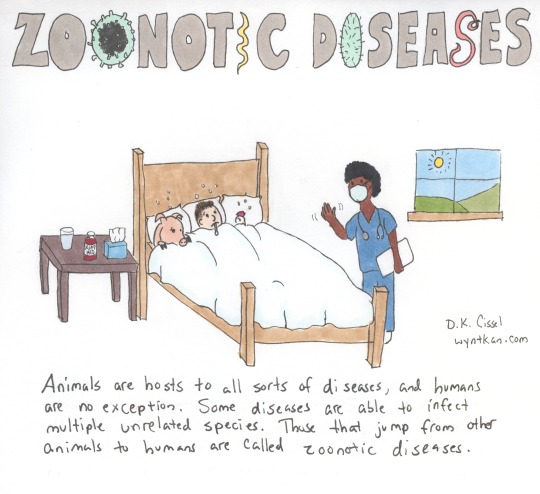
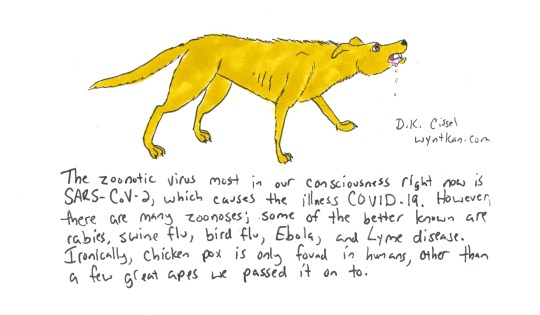
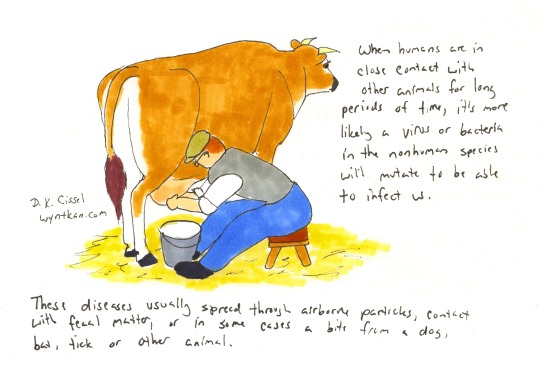
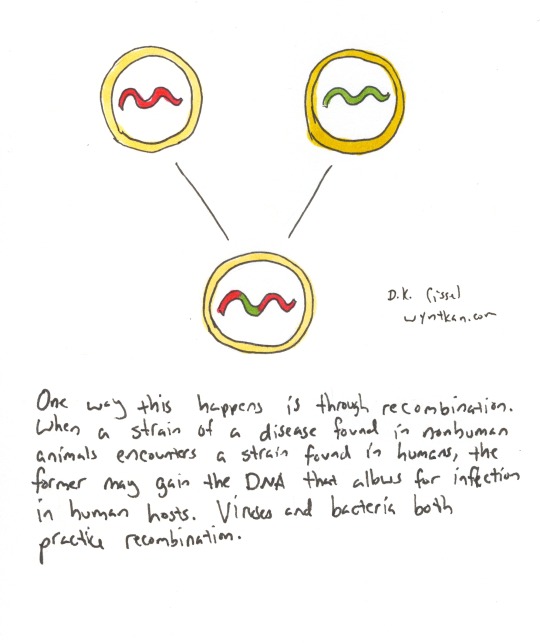
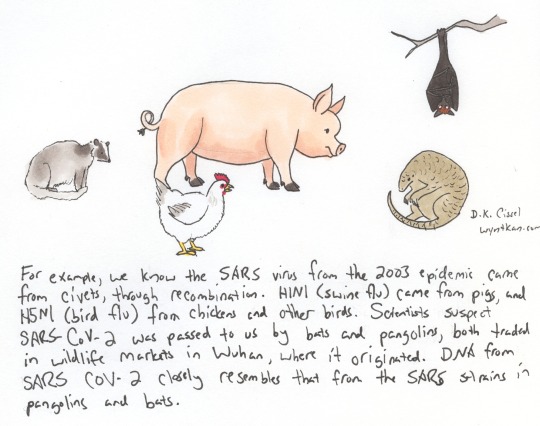
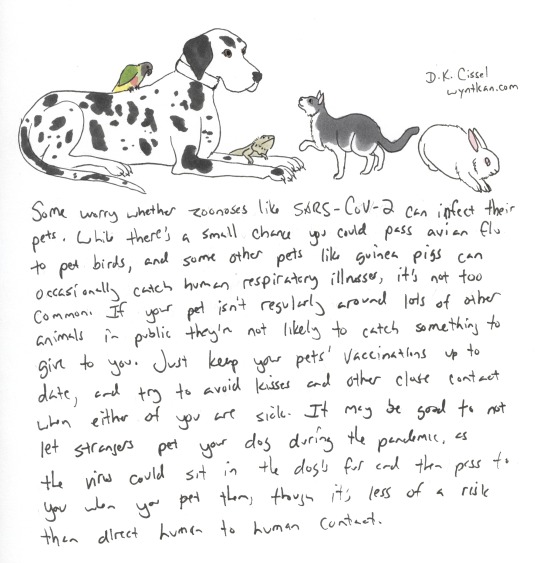

I actually had a different multi-page comic prepped for today, but over the weekend I got a wild hare to do something on topic right now. So if you've ever wondered how a disease can jump from other animals to us, now you know!
Species portrayed: Rabies virus (Rabies lyssavirus), SARS-CoV-2, Lyme disease (Borrelia sp.), Ebola (Ebolavirus sp.), human (Homo sapiens), domestic pig, (Sus scrofa domesticus) domestic chicken (Gallus gallus domesticus), domestic dog (Canis lupus familiaris), domestic cow (Bos taurus), masked palm civet (Paguma larvata), Chinese pangolin (Manis pentadactyla), large flying fox (Pteropus vampyrus), domestic cat (Felis catus), Senegal parrot (Poicephalus senegalus), bearded dragon (Pogona sp.), domestic rabbit (Oryctolagus cuniculus domesticus)
(Just a reminder that I have stickers and other fun merch at my Redbubble store, and you can also tip me for my work at my Ko-Fi! Like many people, my income has been pretty badly affected by current circumstances, so every little boost will help.)
Transcript under cut.
[Title: Zoonotic Diseases - the second O and the I in Zoonotic, and the I and season S in Diseases have been replaced by drawings of bacteria and viruses]
[First panel: A doctor in scrubs and carrying a chart waves to a man, a pig and a chicken all laying sick in bed. A table by the bed holds tissues, cough medicine and a glass of water. The window nearby shows a view out onto a sunny landscape.]
Animals are hosts to all sorts of diseases, and humans are no exception. Some diseases are able to infect multiple unrelated species. Those that jump from other animals to humans are called zoonotic diseases.
[Second panel: A yellow short-haired dog snarls and foams at the mouth.]
The zoonotic virus most in our consciousness right now is SARS-CoV-2, which causes the illness COVID-19. However, there are many zoonoses; some of the better known are rabies, swine flu, bird flu, Ebola, and Lyme disease. Ironically, chicken pox is only found in humans, other than a few great apes we passed it on to.
[Third panel: a man sits on a stool while milking a Jersey cow into a pail.]
When humans are in close contact with other animals for long periods of time, it’s more likely a virus or bacteria in the nonhuman species will mutate to be able to infect us. These diseases usually spread through airborne particules, contact with fecal matter, or in some cases a bite from a dog, bat, tick or other animal.
[Fourth panel: Three circles with squiggles inside them represent viruses. One has a red squiggle, another has a green squiggle, and lines from these two point to the third which has a red and green squiggle.]
One way this happens is through recombination. When a strain of a disease found in nonhuman animals encounters a strain found in humans, the former may gain the DNA that allows for infection in human hosts. Viruses and bacteria both practice recombination.
[Fifth panel: Several animals are on a blank background, including a masked palm civet, a domestic pig, a domestic chicken, a Chinese pangolin, and a large flying fox bat.]
For example, we know the SARS virus from the 2003 epidemic came from civets, through recombination. H1N1 (swine flu) came from pigs, and H5N1 (bird flu) from chickens and other birds. Scientists suspect SARS-CoV-2 was passed to us by bats and pangolins, both traded in wildlife markets in Wuhan, where it originated. DNA from SARS-CoV-2 closely resembles that from the SARS strains in pangolins and bats.
[Sixth panel: More animals on a blank background, including a Senegal parrot sitting on the back of a great dane, a bearded dragon, a domestic cat, and a domestic rabbit.]
Some worry whether zoonoses like SARS-C0V-2 can infect their pets. While there’s a small chance you could pass avian flu to pet birds, and some other pets like guinea pigs occasionally catch human respiratory illnesses, it’s not too common. If your pet isn’t regularly around lots of other animals in public they’re not likely to catch something to give to you. Just keep your pets’ vaccination up to date, and try to avoid kisses and other close contact when either of you are sick. It may be good to not let strangers pet your dog during the pandemic, as the virus could sit in the dog’s fur and then pass to you when you pet them, though it’s less of a risk than direct human to human contact.
[Seventh panel: A golden retriever in green scrubs and a stethoscope sits looking at the viewer. Next to her is a sign that says “Wash hands! Clean everything! Lots of space! Good hygiene! Let wild animals stay wild!”]
How do we prevent zoonoses? By limiting close exposure to wild animals, and keeping all captive animals in clean, uncrowded quarters. Treat sick animals as soon as possible. If you handle animals, even pets, wash your hands thoroughly before eating, drinking, or otherwise putting your hands near your face. Be familiar with zoonoses that the animals in your life may be susecptible to so you can all stay healthy!
35 notes
·
View notes
Text
COVID-19 and the Epidemiology of Zoonotic Disease in Relationship to Modern Human Industry: Educated Guesses from an Amateur’s Brief Research
Wikipedia's basic description of the SARS-COV-2 says that while bats are the most likely natural reservoir, the genome of the virus as it exists in bats is just different enough from the human strain that there was probably an intermediate host between bats and humans. In other words, the virus probably did not come from people EATING bats, nor purchasing bats from the market, but perhaps it did come from going to the market to purchase bats for eating.
I find Wikipedia's explanation plausible because of an article I read on Chuangchn.org, which asserts that we get epidemics when an expansion of human activity into wild microbial reservoirs allows certain viruses to hit crowded populations with low immunity, be they livestock feedlots or slums full of severely stressed humans. Normally those reservoirs have buffers against infecting humans because of a great genetic variety among the wildlife, such that any one strain can only spread so far; as modern capitalism steadily reduces the size and genetic variety of wild populations, their attendant microbial parasites have fewer barriers against reaching humans.
So you get one virus running into, say, a vast pen of cattle, and as the cattle have no immunity, the virus faces very little selection pressure that would force a greater genetic variety. Instead the selection pressure is to spread as fast as possible, which means to grow as fast as possible, and the faster a virus grows, the more strain it places on the host, so within a short time the virus goes from benign to deadly.
And so you tend to get epidemics coming close on the heels of major capitalistic shifts in the concentration of living creatures. English outbreaks came in the era when they began to enclose their cattle in pens; the Spanish Flu started in the pigs of a Kansas stockyard shortly following the rise of American industrialized agriculture.
Admittedly these viral outbreaks can occur with direct human incursions into the wild, either by incorporating wild animals into modern markets or simply pushing industrialism into wild areas. Ebola seems to have appeared first in the 1970s with an English-owned cotton mill operation that planted itself in the central African jungle and occurred again every time that sort of industrialism increased its presence in the area. Likewise HIV is said to have come from humans eating "bushmeat", which is any manner of monkey meat, as if humans had not been doing such a thing before, so that they had no immunity to what they found within those animals -- maybe, then, they were going after bushmeat because their usual food sources were out of reach? Oh, wouldn't it be interesting if HIV and Ebola came from the same damn cotton mill!
This is not the case. According to the Chuangchn article, Ebola was first recorded in 1976 where the most common strain of HIV appears to come from early-20th-century Kinshasa, or should I say Leopoldville, the capital of the Belgian Congo and centerpoint for a great deal of environmental degradation and societal upheaval through modern capitalism. Bushmeat had been a common food source for a long time, with Simian Immunodefficiency Virus being endemic in wild primates. People used to catch SIV all the time. They resisted it well and fast enough that it could never spread from human to human. Then Leopoldville created a world where increased prostitution could spread syphilis more quickly, such that the ulcers which present the greatest danger of transferring SIV were all over the place, and SIV was now able to jump from one person to another fast enough to mutate into HIV.
Now as for Ebola and HIV, both of those diseases are more deadly than the diseases that seem to come from livestock concentration. One of them is a hundred percent fatal, the other fifty percent without treatment. Likewise the source of the Black Plague was Central or East Asian rodents moving into human agricultural areas due to climate change, and the disease itself appears to have an untreated mortality rate of thirty to sixty percent if bubonic, one hundred percent if pneumonic or Septicimic -- as if a wild microbe that hits human populations without an intermediary host is invariably more deadly than one that arises out of the intermediary host.
That's assuming the Plague hit humans directly through people eating gerbils in the manner of people eating Bushmeat to catch SIV, and that neither rats nor fleas were the intermediate host where the bacteria could go from benign to virulent. To compare the Black Plague to Ebola is also to conflate the behavior of viruses with bacteria. I do not know if they would react to certain selection pressure the same way.
All I know is that these microbes which become dangerous among crowded livestock seem to have a lower, or perhaps slower, mortality rate than the ones which develop from direct wild-to-human transfer. The zoonotic diseases that humans are supposed to have picked up from livestock at the beginning of human-animal domestication -- Tuberculosis, Smallpox, Cowpox, Glanders, Escheria Coli, and so forth -- generally have a much lower mortality rate than Ebola, with only Smallpox reaching the untreated mortality rate of the Black Plague --
In populations already exposed to the disease, at any rate. For virgin populations such as the entire Western Hemisphere circa 1492, the untreated mortality rate was something even Ebola could not match. It may simply be that the zoonotic diseases livestock herders are familiar with are less deadly because their most dangerous strains burned themselves out tens of thousands of years ago. In that sense, the only real difference between zoonotic diseases incubating in livestock and those hitting humans directly would be the novelty, where these wild diseases, being invariably new to us, have not yet burned through enough people to create a selection pressure towards less fatal strains.
One might argue that Rabies has been known for many thousands of years and remains as deadly as it ever was, and is a very good example of how dangerous a virus can be when it infects humans directly from the wild. But the fact that Rabies spreads though biting means that it's not viral in the same way as most other diseases. Despite the fact that the virus itself has an evolution rate similar to any other RNA virus, it doesn't have the transmission rate of most other RNA viruses, so I would expect that its effective rate of evolution is much too slow to force it into something less deadly.
In point of fact, of the seven major species in the Lyssavirus family, nearly all of them follow the same pattern as Rabies: bats as a wild reservoir, human transmission through biting, fatal if untreated, human transmission extremely rare. Only Mokola Virus is endemic in mammal populations like the Rabies we know, and then only in South Africa; as it has the possibility of being transferred by Mosquitoes, it may have a much shorter time scale for selection pressure than any other Lyssavirus and, as it happens, one of the two humans who contracted the disease recovered. Nor do the cats infected with Mokola Virus exhibit unprovoked aggression in the manner of Rabies. While all these strains appear to have evolved within the last 1500 years, only Mokola Virus appears to face enough selection pressure to evolve into a milder form. For the rest, they still run wild, and it will be a long, long time before they settle down.
Rabies remains deadly for being new in comparison to its evolutionary time scale, and HIV remains deadly for being new in relation to its own time scale, and Ebola remains deadly for being new in general, where livestock-zoonotic diseases have been facing more intense selection pressure for quite a while longer than these diseases direct from the wild. We're all virgin populations for Ebola, Rabies, and HIV like the Western Hemisphere was a virgin population for Smallpox. That's a more prosaic explanation for this discrepancy than some aspect of livestock that makes their epidemics less deadly...
Especially since James Gallagher at the BBC News says HIV is already adapting into a slightly less deadly form as it gets used to human immune systems.
And yet the initial outbreak of SARS in 2003 was entirely novel, it came from a wild vector and its case fatality rate was an average of nine percent. That looks like a case of a novel wild virus with direct transfer being much less than fatal. Palm Civets, there you go, there's the vector, right? Except that these palm civets were in the wild-animal MARKET, and the virus itself has a wild reservoir in bats, so if the civets were shoved in close together like any livestock then the disease would have developed within their population just the same as if they were all pigs. I can't say that SARS was a direct transfer from the wild.
As for this Novel Coronavirus...while Hubei does a lot of livestock operations but the pandemic has been traced to Wuhan's Huanan Seafood Wholesale Market, which also sells lots and lots of wild animals, quite similar to the meat market in Guandong where the 2003 SARS came from. As I imagine it, the virus started from one bat, incubated among wild animals crowded together, and developed in just the same way as 2003 SARS.
The fact that the virus appears to have a low variability among known genomic sequences stands in marked contrast to HIV, which has a great deal of genetic variability in its many subtypes, and Ebola, which is an entire genus of viruses, as well as the aforementioned seven species of Lyssavirus, of which Rabies is but one part. It is as if this novel Coronavirus hit a crowded population just once and took off from there, facing, as I said, no selection pressure to force genetic variety, where viruses picked up directly from the wild have competed against their wild hosts a long time before ever reaching humans.
I imagine the scenario as follows:
1. A living landscape in its proper state has a great deal of genetic variety among its multicelled organisms.
2. This variety creates an evolutionary selection pressure in their attendant microbial populations, which means these microbial populations will have a degree of genetic diversity matching the macrobial popluation.
3. Humans pushing their industry into these areas for the first time reduce the genetic diversity of the area, thereby reducing the diversity of immune responses, and letting certain microbes spread farther.
4. At the same time, humans pushing industry into these areas are coming across populations of wild microbes that still have a high degree of genetic diversity.
5. Humans doing the grunt work in this industrial push have many opportunities for contact with this population of wild microbes through direct contact with wild animals.
6. Wild microbes enter the human population with multiple strains, be they subtypes or whole species, where a wild microbe hitting a stockyard first would be only one or a very few strains.
7. Having a high degree of genetic variety from the start, they have much more chance to compete against human immune systems than the intermediary-incubated epidemics, so they are invariably more damaging to their human host.
8. By the same token, they cannot be endemic among human populations like the diseases that grew out of microbes hitting livestock operations, because as they have survived within wild macrobial populations that resist them well, they are optimized for surviving within a host and against virulence. Their methods of human-to-human transfer, be it saliva, sexual intercourse, or skin contact, have a low rate of success compared to the livestock-incubated diseases.
See for example Leprosy, which appears to have a wild reservoir in Red Squirrels, does terrible things to its victims, and...is not very contagious between humans.
The existence of Cholera complicates this picture because it is an incredibly deadly disease like Ebola, and it seems to be endemic to human populations, in contrast to Ebola which disappears until industry expands into the jungle again. And it is extremely virulent, without having a stealthy effect on humans. How does Cholera win the epidemic jackpot? By having its wild microbial reservoir in water. Water contaminated with fecal matter causes zooplankton to pick up the bacteria; oysters then eat the zooplankton; humans eat the oysters, and get sick; suddenly they’re contaminating the water with their own fecal matter and the disease is living free in the local water for a while, and everyone else gets it. Cholera is unusual for having a wild reservoir that is invariably close to human habitation, such that it remains endemic without becoming any less wild. Let us say, then, that Cholera is not endemic to humans, but is endemic to a source so close to them that it might as well be. It comes in waves, because it comes on the waves.
Perhaps not so unusual. There is a land-based wild reservoir that resembles that of Cholera. Once upon a time, there was once another extremely virulent and deadly disease in the manner of Cholera, called the English Sweating Sickness. It killed its victims in the space of hours, and had outbreaks from 1485 to 1551. The most likely source was a strain of Hantavirus with a wild reservoir in rodents. Like the schools of wild fish, its reservoir was constantly interacting with human populations, as rodents broke into human food stores. English Sweating Sickness has never been seen again, but Hantaviruses remain quite dangerous, enough so that a discovery of mouse droppings in a human space demands immediate and thorough cleanup.
I find it telling that the aforementioned article mentions this English Sweating Sickness coming in a time of agricultural and social upheaval. I also find it telling that Wikipedia attributes the first major recorded Cholera epidemic to increased commerce, pilgrimage and migration. Just like folks in China hitting the SARS viruses, eh? Wuhan’s meat market has a bunch of wild animals to sell because people are running into them more, as they push capitalist industry further into wild spaces. So those wild microbes hit populations that are tailor-made for turning a virus into an epidemic. These wild reservoirs are somewhat dangerous on their own, as Rabies and Lyme Disease will tell. You can walk in the forest without fear of breathing them in, as long as you avoid getting bit by anything. But to destroy their habitats, to reduce the genetic diversity of those places, so that there's less buffer between the viruses and us, just for the sake of making more money faster, well...that’s when these critters get into our lungs.
It’s the interface of an increase in Intensive Industrialism with Wilderness that does the trick.
As I live in the Northeast United States, in the foothills of the northern Appalachian Mountains, I and all my friends deal with this every damn summer when we have to worry about Deer Ticks. Those didn’t become a problem until people shoved their big suburban houses up against the woods just as they were coming back, and in the new forest with new deer populations there were no wolves, so there’s deer everywhere and there are deer ticks everywhere. Lyme Disease gets into a person and it never goes away on its own, but gums up your joints and wears you down over the years if left untreated. Call it the AIDS of New England. Human immune systems can’t handle AIDS nor Lyme Disease, and I don’t think that’s a coincidence. Lyme Disease is yet another virus direct from the woods.
Supposedly Poison Ivy comes from the same issue, for as people shove their houses up against the woods they create more of the edge-forest area where Poison Ivy thrives.
It’s that edge that does it. The edge between Industry and Wilderness, that’s where the world boils and roils and spits out hot stuff like someone put too much oil in the fry pan. Edge environments always have the most activity in the first place even if they’re All Natural. Continental shelves, forest edges, river banks, lake shores, swamps, salt marshes, whatever the biologists will call an Ecotone. That’s where the living world boils and roils, as the creatures of one biome meet another. If Intense Human Industry barges into the place and smashes it up without an ounce of caution -- well, the results are like someone smashing a fist into a frypan of simmering oil.
“That’s what you get for messing with the Wilderness!” cry the Eco-facists and all the folks who think humans are a disease upon the earth. “Mother Gaia takes her revenge! So there!”
And there I come to the one part of Chuangchn’s article that I really disagree with. The author thinks that we’re Losing The Wilderness. But I don’t think we’ve ever really had any. Not Wilderness with a capital W, at any rate. Humans have been significant shapers of the living landscape for tens of thousands of years. Our species has been fairly well integrated with the world and highly influential, a lot like beavers making ponds all across northeast North America. In the same time period as beavers, humans were setting enough small fires in the Jemez Mountains of New Mexico to be a bigger factor for forest fires than the climate was. Likewise the Amazon Rainforest that we think of being a Pristine Landscape Untouched By The Hand Of Man was actually shaped by centuries of human activity. Humans made all the terra preta that you can find throughout the rainforest. Hard to believe that they could make fertile soil without livestock! I will leave you to guess of where that manure came from.
Indeed, to speak of "wilderness" implies that we are separate from the world, and it is this mindset that leads us to set aside certain areas as Natural Pristine Beauty and then pave over everything around them. Both lands are thus diminished by the desire for Purity. If we were willing to incorporate the rest of living world, letting it live and grow with our influence but not our destruction, as once we used to, such that the genetic variety of the world was not reduced -- perhaps then we would not have these epidemics after all. It is not that we need to Preserve The Wilderness so much as we need to become part of the world again.
As it is, capitalism prefers that this does not happen, because it means a slower increase in personal wealth for the select people holding all the money. Capitalism does not live and let live. It cannot. The system wants more, more, more, faster and faster. To clarify: certain people holding all the money want more, more, more, faster and faster. There is no place they would let alone if they could make lots of money off it soon, nor any place they would let make money slowly when it could make money quickly. So you see people choosing to strip-mine a place instead of sell tickets for river rafting.
This was never necessary, except to serve the greed for personal wealth and power. And yet, was it even necessary for that? The Empire of the Incans functioned without money or markets, as did every civilization for thousands of years, until someone invented coinage around the 600s BCE. Plenty of wealth and power to be had without coins, surely! The real value of money is liquidity and speed, and some people want their fortune Now. Maybe it’s the Greed For Speed that makes the difference between the power-grabbing of an aristocrat and the power-grabbing of a merchant.
And so as we alter the landscape too fast it cannot adapt in time, and suffers greatly.
We see the results in one epidemic after another. It’s not Gaia’s Revenge; it’s just the fallout of us setting things up to make a virus’s happy accident our unhappy accident, time and again.
#Coronavirus#covid-19#epidemic#epidemiology#capitalism#if I was a real researcher this thing would have taken me a week and it would be closer to the mark#as it is it took a day#but I have done my best from the sources I could find#I have tried to make sure that my educated guesses are reasonable and well-supported#such that this essay will contribute to your understanding of the issue#instead of leading you astray#make of it what you will
14 notes
·
View notes
Photo

1. Second in the World
It’s the world’s 2nd largest traded commodity. Crude oil is first. Yes, it is not a typo. Coffee is consumed in great quantities, making it the most beloved beverage after water. It’s worth is over $100 billion worldwide.
2. Hawaii is the only American state that grows coffee
Good coffee growing conditions require high altitudes, tropical climates, and rich soil. There is only one state, Hawaii, which is able to grow coffee. It has been producing coffee even before it was a state. (Only recently, though, farms in California started growing coffee bushes!)
3. Coffee was discovered by a goat herder
It was said that coffee was discovered by a goat herder in Ethiopia in the 1500s. He saw his goats eating coffee cherries. Afterwards, he observed a change in their behavior. They gained a high amount of energy and they didn’t sleep at night. The herder shared his findings with local monks and then after they made a drink with coffee beans, they realized they could stay up all night and pray. Then, they spread the word to other Ethiopian monks and it reached across the civilized world.
4. Coffee helped Olympic athletes
Brazil couldn’t afford to send its athletes to Los Angeles for the 1932 Olympics, so the government loaded them in a ship full of coffee which was sold on the way to finance their trip.
5. Mecca banned coffee
Coffee was banned in Mecca in 1511. It was believed to stimulate radical thinking and idleness.
6. Add cream, keep your coffee warm
Coffee stays warm 20% longer when you add cream.
7. Divorce because of terrible coffee
In ancient Arab culture, a woman could only divorce her husband if he didn’t like her coffee.
8. Italian “expresso”
The word espresso comes from Italian and means “expressed” or “forced out”. Espresso is made by forcing very hot water under high pressure through finely ground, compacted coffee.
9. Coffee is a fruit
Coffee beans grow on a bush. They are actually the pit of a berry, which makes them a fruit. There are two main varieties of beans, green and red. Red beans have a
nicer smell and are less acidic. Red beans are used to produce lighter coffees. The longer that coffee beans have been roasted – the healthier they are. Decaffeinated coffee comes from a chemical process where the caffeine is taken out of the beans. The caffeine is then often sold to Coca-Cola.
10. Beethoven loved coffee
Beethoven was such an ardent coffee lover that he’d count 60 beans per cup before making his brew.
11. The most expensive coffee is made by cat poop
“Kopi Luwak” is the most expensive coffee in the world. It comes from Indonesia and is made from beans digested from the Asian Palm Civet. In other words, it comes from cat poop. It sells for €350 and up per kilo!
12. A year drinking coffee or an iPhone X?
An American spends on average $1,092 a year on coffee. That’s around $20 a week. That is also close to the price of the newest iPhone. Young people generally spend more on coffee than older people.
13. Fairtrade coffee improves quality
Fairtrade coffee costs more, but coffee farmers spend at least 25% of this Fairtrade Premium to enhance productivity and quality. Over the last three years, Fairtrade-certified coffee products have won 28 Great Taste Awards.
14. There are 2 types of coffee
Arabica coffee was originally cultivated on the Arabian Peninsula, hence the name. Robusta coffee is a more hardy plant but contains double the amount of caffeine.
15. Europe loves coffee
According to International Coffee Association, Europe imports more coffee than the USA. Also, Brazil is the lead exporting country in coffee.
#foof#cooking#coffee#usa#europe#food#facts#food facts#fun facts#foodforthoughtposts#cartoon#gif#meme#nafta#south america#hawaii
9 notes
·
View notes
Text
Most Expensive Food in the World (Revealed)

because the food programme explores in ‘britain's mystery saffron story’, the pink spice is one of the international’s most high priced substances – really worth more according to ounce than gold. However what other ingredients would provide the sought-after spice a run for its cash? What is it that makes these merchandise so luxurious? And are they surely well worth their charge tag? Here are some of planet earth’s maximum pricey foodstuffs. How many have you tried?
1. Saffron
if your rice is luminous yellow, then the chances are it’s been sharing a saucepan with saffron. The spice, nicknamed ‘pink gold’, is the shiny crimson stigma (or threads) from a crocus flower, and it’s used as a colouring agent in meals. Why does some thing so small value so much? It's miles, weight for weight, extra costly than gold itself. The motives are easy: saffron crocuses only flower for per week or a year inside the autumn; harvesting the spice is labour in depth (it’s amassed and processed through hand); and each small flower has simplest 3 stigma this means that it takes around soccer pitches of crocuses to create a kilogram of saffron. That’s as many as 300,000 flowers! 2. Caviar
caviar is the pickled roe of the sturgeon fish, and considered one of the international’s great delicacies. It’s difficult to handle and package deal but, extra significantly, it’s relatively uncommon. The most well-known caviar is from the beluga sturgeon – observed in the caspian and the black sea. Now seriously endangered, very little of its eggs may be bought legally. It takes up to two a long time for the beluga sturgeon to attain maturity and it’s grownup length! Even rarer is the roe from the albino sturgeon - now nearly extinct in its native environment. In keeping with the guinness international data, the maximum expensive caviar recorded is from an elderly (probably 100 year-antique!) albino beluga sturgeon whose white caviar offered for about $34,500 in step with kilogram. My cod that’s steep! 3. Oysters
now taken into consideration a luxury, oysters haven’t continually been the food of the filthy wealthy. Within the early nineteenth century oysters were reasonably-priced as chips and an crucial food source for the working classes in coastal communities – a snack so plentiful that they were used to bulk out meat pies. From plentiful to rarity, the fee of oysters has gone up drastically! But overfishing and pollutants have had a catastrophic effect on oyster shares and shortage has bumped up their cost. A dozen in a top london seafood eating place will set you back round £fifty one. It seems a few human beings are satisfied to shell out for a slimy mollusc or … of route, you’re also buying the oyster’s infamous aphrodisiac characteristics. Be careful who you dine with! 4. White truffle
discovered within the piedmont place of northern italy, exceptionally esteemed white truffles will best develop amongst the roots of sure trees, are a great deal scarcer than every other form of truffle, and feature a in particular extreme flavour and aroma. They are able to’t be cultivated or grown – although folks have attempted for generations to farm the truffles, they are able to nevertheless most effective be sourced within the wild. It's miles this unpredictability, at the side of the lengths people go to to locate and harvest them, which leads to their hefty fee tag. The report sum paid for a unmarried white truffle changed into via macau casino proprietor stanley ho in 2007. He splashed out $330,000 (£165,000) for one among the largest muffins exposed in decades – weighing 1. Five kg. A quite exceptional rate for a pungent underground fungus. 5. Iberico ham
a sort of cured ham produced in spain and portugal, the finest iberico ham is from free variety pigs that have a food plan of only acorns over the past duration in their lifestyles. The class of iberico ham is extraordinarily strict, with ‘black label’ ham considered to be the very excellent – made out of natural-bred iberian pigs, roaming very wellforests and feasting on acorns. On top of that, the ham is cured for a prolonged 36 months! In keeping with the guinness global records, the maximum high-priced leg of ham commercially to be had is an iberian ‘manchado de jabugo’, retailing at a whopping £3,192. 76 (as of 20 march 2016). Despite the fact that the pigs are reared for just 3 years, the ham legs are then cured for up to six! 6. Wagyu beef
wagyu in reality translates as ‘japanese pork’, and it can come from any of 4 one of a kind breeds of eastern cow. The meat is intensely marbled with fats, which renders down during the cooking procedure to make the meat smooth, moist and soften within the mouth. Some enthusiasts describe it as falling aside like a tender piece of fish. The excessive price factor is all down to the rearing procedure: to qualify for the wagyu mark the cows must be reared and fed in line with strict recommendations, with calves being given special feed to guarantee the signature fatty marbling. Kobe pork, one of the maximum pretty-prized, fetches as much as £500 a kg in japan. That’s a number of moo-ney. 7. Kopi luwak espresso
good enough, so technically it’s a drink. However with luggage of kopi coffee promoting for as much as $seven hundred in step with kg, it’s honestly worthy of its location in this list. Kopi luwak, or civet espresso, is made from espresso beans eaten, partly digested and then defecated by means of the asian palm civet or civet cat. Doesn’t sound all that appetising? Continually test wherein your coffee comes from. A few believe that the part digestion and fermentation caused by the animal’s belly acid complements the flavor of the coffee, with other critics in settlement that it’s simply a gimmick ensuing in a in reality horrible coffee. Unluckily, there are growing numbers of extensive civet farms, in which animals are restricted to cages similar to battery hens, and pressure-fed. It’s well worth doing your studies earlier than shopping for. 8. Foie gras
foie gras is a costly pâté made from duck or goose liver that has been fattened (to up to ten times its ordinary size). The flavour is wealthy, buttery and delicate and the product pricey however the birds pay a better rate than we ever will – the geese and geese are force-fed corn through feeding tubes. It’s a practice dating lower back to as early as 2500 bc, whilst the historical egyptians found out that many birds can be fattened via compelled overfeeding. Nowadays many countries have laws in opposition to the practice, and the production, import or sale of foie gras.
3 notes
·
View notes
Text
Tip of the Nose : You Be For Men, My Scent
Does perfume really have a gender? Not remotely likely, says the purist, and don’t come telling me that virility smells like those pine-shaped car deodorant thingies. Everybody knows that real men smell of lavender.
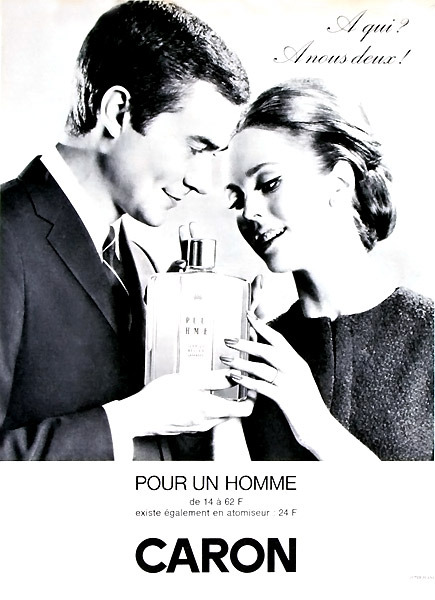
This article is actually a rewrite of my response to this post, which my dying aging computer ate right before I thought about saving three hours worth of work. I’m not entirely sure what burning frustration and bitter regret are supposed to smell like, but if someone wishes to bottle it, they may as well name it Parfum de Hel.
On a side note, one of the participants to the earlier conversation had me blocked for some previous reason—probably unrelated to perfume discourse—so I could not reblog the initial post; nor am I willing, out of politeness, to simply caption the discussion. Therefore, here is the original post, and following is the segment I will more precisely address:
@thatiswhy:
Also, maybe I hate the mainstream cotton candy uwu line for women but don’t want to smell like a fucking frat house trying to deo away the smell of vomit on the carpet. You know what I want to smell like? White musk, and leather, and cedar, and sandalwood, and old parchment, and vetiver, and various teas, and juniper, and citrus, and cypress, and cashmere wood, and maybe in the summer like orange blossom and jasmine or fresia. These notes, while mostly present in women’s perfumes, usually are combined with overbearing fruity or flowery tones that make it smell like an aging late 17th century courtesan’s drawers, or “oriental” scents that make the whole thing reek like a 1920’s opium den. (Seriously, I have walked into a perfume shop, asked to be shown something fresh, woodsy and clean, and had Gabrielle shoved under my nose, which smells like rosewater-flavoured Turkish delight.)
Let women smell of non-jellybean scents, you cowards.
That being said, I have found all but two scents for men (to date) that don’t smell absolutely abrasive. (I’m suspecting the cheap synthetic ambergris.) 99.9% of the stuff directed at men smell as if I had one of those scrubbing metal wire thingies shoved up my throat. So no, I don’t want to shop at the men’s section, I want to be given the opportunity to find a scent that doesn’t say 80’s cartoon for girls and/or I read palms for a living.
There are many things to address in this fertile, if angry, intervention, and like often I’m starting by the end and by making a remark that has little to do with the subject at hand: I don’t think, my darling Tatty, that the ‘abrasive’ harbinger of olfactory doom you perceive in most ‘masculine’ fragrances would be synthetic ambergris, cheap or other. All ambergris today is synthetic, to begin with—well, not all, but natural ambergris is so terrifyingly expensive that we’ve got to forgive perfumers for furnishing us with only an approximation. Ambergris is extremely rare a substance; think around €10,000 per kilogram, in the lower estimation. Back in 2016, a nearly two-kilo block found by a man who was walking his dog on a Lancashire beach sold for £50,000… People have become millionaires over ambergris, although most of the time one only finds small quantities of it at once.
Now this ambergris is a very curious substance, and so important as an article of commerce, that in 1791 a certain Nantucket-born Captain Coffin was examined at the bar of the English House of Commons on that subject. For at that time, and indeed until a comparatively late day, the precise origin of ambergris remained, like amber itself, a problem to the learned. Though the word ambergris is but the French compound for gray amber, yet the two substances are quite distinct. For amber, though at times found on the sea-coast, is also dug up in some far inland soils, whereas ambergris is never found except upon the sea. Besides, amber is a hard, transparent, brittle, odourless substance, used for mouth-pieces to pipes, for beads and ornaments; but ambergris is soft, waxy, and so highly fragrant and spicy, that it is largely used in perfumery, in pastiles, precious candles, hair-powders, and pomatum. The Turks use it in cooking, and also carry it to Mecca, for the same purpose that frankincense is carried to St. Peter’s in Rome. Some wine-merchants drop a few grains into claret, to flavour it.
Who would think, then, that such fine ladies and gentlemen should regale themselves with an essence found in the inglorious bowels of a sick whale! Yet so it is.
— Herman Melville, Moby Dick (1922), chapter XCII, ‘Ambergris’.
In perfumery, ambergris is distilled into an alcohol-based solution known as ‘pure amber’ which, when exposed to air and sunlight, can be separated into several derivatives, notably terpenes and steroids. In fact, ambergris is mainly constituted from ambrein (25–45%) and epicoprosterol (30–40%). Ambrein is progressively degraded by sea water, sunlight and air into several compounds which are chiefly responsible for its smell, notably ambroxide and ambrinol. Modern perfumery uses ambroxide as a substitute for natural ambergris, which is easily synthesised from… a type of sage plant! To be exact, from sclareol, a fragrant chemical compound found in clary sage (Salvia sclarea). Sclareol kills cancer (yes.), and also it smells really good, with a sweet, balsamic scent very reminiscent indeed of the most important notes of natural ambergris.
Ambergris is essentially mucus naturally produced by certain sperm whales (it is believed that less than 5% of the species produces ambergris, possibly the largest of them, which prey on bigger animals) to protect their intestinal tract from lesions caused by the passing of sharp objects, chiefly undigested squid beaks: eventually, the whale excretes this soft, blackish, pungent concretion which is going to drift for a long while before landing on the shore, where it’ll spend maybe years drying out and hardening under the sun and the air. The colour lightens to a golden grey, and the smell gradually sweetens to a salty musk with whiffs of honey, tobacco and leather—depending on the block, the notes will vary in proportions and in potency.
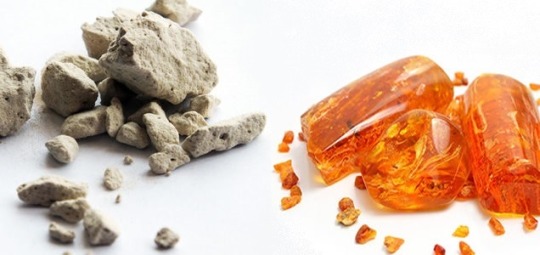
Almost needless to say, then, that the number of perfumes using authentic ambergris isn’t especially high. Conversely, synthetic ambroxide is a beloved template of the modern perfumer’s palette, one of the reasons being that it helps stabilise scents very well. So popular, in fact, that specialists speak of 40% of the perfumes created in the last thirty years using it! Ambroxide was first synthesised in 1950, by Max Stoll for Geneva-based Firmenich SA. That means that Aimé Guerlain had to use natural ambergris when he created the masterpiece Jicky in 1889 (the oldest perfume in the world to be sold without interruption since its creation), even though Jicky was amongst the very first perfumes to use synthetic ingredients! Most notably, Jicky pioneered a great use of several synthetic molecules, chief of which vanillin, the synthetic vanilla which had been discovered in 1874 by German chemist Ferdinand Tiemann. (The first perfume using synthetic ingredient was Houbigant’s Fougère Royale in 1882, using coumarin, one of the key molecules of tonka beans.)
According to the legend of Jicky, it was composed by Aimé Guerlain (one of founder Pierre Guerlain’s two sons, and the second generation’s in-house perfumer, whilst Gabriel was the manager; then came Gabriel’s own sons, master perfumer Jacques and manager Pierre. The last family perfumer was Jacques’ grandson Jean-Paul, who retired heirless in 1994, after which the company was sold to soulless, tentacular multinational LVMH, much to the dismay of Guerlain aficionados all over the world) ... in memory of a broken heart he suffered in his youth as he came back to France after studying in England without his lady love, the lovely ‘Jicky’. Though mostly advertised to a female clientèle, Jicky shocked many a respectable woman of the time by its daring use of sensual animal musks (ambergris, musk, castoreum, and the devilishly sexual civet) at the heart of its balms, spices and aromatic flowers, most especially lavender, luxurious iris, sultry sandalwood and hot leather... Until the 1910s, when women’s press began recommending it, Jicky was quite the sensation amongst... English dandies... and Marcel Proust, of course. (In 1925, for the International Exhibition of Decorative Arts, Jacques Guerlain presented a twist on Jicky, in which he had removed lavender and woods but added bergamot and, especially, a massive dose of ethylvanillin [three times more potent than vanillin!]: Shalimar was born.)

Men and women used to wear the very same perfumes. Until the 19th century, really, the market wasn’t segmented and there was no such thing as a masculine scent. When the European courts started bathing again and heady perfumes fell out of fashion to the benefit of lighter, tarter, fresher fragrances modelled after the famous Eau de Cologne (1708), women wore them too. The French Jean-Marie Farina who became with his own Eau de Cologne (1809) the official perfumer of the imperial court furnished Empress Joséphine as well. It was for Empress Eugénie, wife of Napoleon III, that Pierre Guerlain created his 1853 Eau de Cologne impériale in the famous ‘bee bottle’ (with his 69 bees symbolising the Empire), which earned Guerlain the envied title of ‘Patented Perfumer of Her Majesty’.
The real difference in perfume usage that occurred during the 19th century was actually a matter of social marking via the use of perfumes of varied qualities, complexities and prestige: if perfume remained an element of luxury, now the aristocracy wasn’t alone in this privilege; moreover, clothes weren’t so elaborate and expensive anymore, and social differences were expressed in subtler ways than before the Revolution. In Paris, House Guerlain furnished a more aristocratic clientèle, whereas the upper-middle class went to Roger & Gallet (successors to Jean-Marie Farina), Lubin or L.T. Piver; meanwhile, middle-middle and lower-middle classes patroned Bourjois and Gellé Frères. The lower-middle class also went to ‘perfume bazaars’ that proposed the same products on sale, plus low-quality products.
The first respectable (only) concurrent to French perfumery was actually England, thanks to the well-earned reputation of its barbers, who created their own fragrances, at once discreet, elegant yet tenacious. Those were scents designed to be applied on the skin as tonics in the first place, after an expert shave, and as such they were based on aromatics, chiefly lavender, made from the essence of the delicate English variety: in the beginning 20th century, Frenchmen often wore Yardley’s 1873 English Lavender, precisely, and it was something of an ubiquitous odour in cosmetic products more specifically destined to men, such as soaps and creams.
It is no wonder, then, that when Ernest Daltroff created the first ever perfume only for men, judiciously titled Pour un homme, in 1934, for House Caron which he co-founded with his brother Raoul in 1904, the fragrance was based on lavender, tenderly joined in matrimony with sweet vanilla and lying on a respectable, tranquil base of an ambre accord (vanilla, benzoin, labdanum, the ‘oriental’ assembly created by genius François Coty in 1908 Ambre antique, the family namer of ambrés perfumes) sandalwood and musk. Legend has it that Ernest, who loved lavender, added the vanilla to please Ms. Félicie Wanpouille, Caron’s artistic counsellor, whom Ernest might have loved even more than lavender. She had joined Caron in 1906 and their collaboration produced some of the most beautiful perfumes of the time, and most original: in 1919, they created the first ever leather-scented perfume, Tabac Blond, in 1927, Ernest made En avion as a gift to Félicie’s friend the star aviatrix Hélène Boucher... They also invented the ‘loose powder’ technique in make-up.
Félicie never left, but Ernest did, along with Raoul, when the Nazis invaded France: the Daltroff brothers were the sons of Jewish Russian immigrants, after all. Since Caron exported a lot of products and had opened a shop on New York’s 5th Avenue, Ernest emigrated to the United States in 1939. He never came back, and died in Canada in 1941. But Félicie Wanpouille stayed, in spite of the Occupation, keeping Caron afloat; 1941 was also the year she got the genius idea, since she couldn’t pay the heavy taxes the Nazis imposed on Jewish-made goods, to rename Pour un homme into Pour une femme, a name which it kept until the war ended. To this day, Caron remains one of the very houses to be devoted entirely to perfume—and free of any multinational’s influence, for that matter. (They’ve not, alas! remained free from the clutch of Reformulation, but that is a story for another day.)

There are two very good reasons why Tabac Blond bears this name. The first was purely commercial: in 1919, women were beginning to smoke, but they smoked almost exclusively blond tobacco from Virginia, which was considered too feminine for men. The second was that blond tobacco exhales honeyed mossy notes which the perfume evoked tantalisingly alongside the darker leather, the cooler iris and the warmer amber, meaning that it was the perfect perfume to cover the smell of tobacco smoke. Two years later, Molinard released the wonderful Habanita, in a small bottle shaped like a cigarette lighter, as an oil to dab the tip of your cigarette so as to make women’s clouds suaver (it was released as a proper perfume in 1924, and long advertised as ‘the most tenacious perfume in the world!’, not without reason).
It wouldn’t be illogical to consider that if there are masculine scent in the first place, it’s probably because femininity went through some drastic changes from the late 19th century onwards, especially as a consequence of the two World Wars. The daring, tobacco-covering orientals which the flappers favoured were a direct reaction to the dreamy flower ideal of the previous decades, notably the artificial immobility of the Victorian woman and her continental equivalents, which the Roaring Twenties more or less exorcised with a call to adventure and independence. Women wore more perfume and more daring perfumes; it was only expected that men would start wearing perfume, real perfume again.
Something really odd happened in the 1980s, but maybe that, too, was to be expected: a kind of paradigm shift occurred in perfumery, as the laundry detergent companies which had become extremely rich and powerful thanks to the combined power of advertisement and mass consumption bought most of the perfume houses, perfume started imitating cosmetics more than the reverse. Once upon a time, the cosmetics industry would copy, or try to, the scents most popular in perfumery, like L’Oréal’s Elnett hairspray famously reprised Chanel’s Nᵒ 5’ aldehyde overdose. Now, trendy perfume smells like shampoo or body spray.
It seems, nonetheless, like the ancestor of all terrible men’s perfumes that smell like body spray—the men’s version, the kind that makes you want to claw your own nose off—was the otherwise respectable Drakkar Noir by Guy Laroche (1982). So beloved by the public that every hygiene or cosmetic product targeted towards suddenly attempted to smell like it. Drakkar, however, was a good perfume, even if by today’s standards it would be perfectly unwearable for one’s entourage (in a vicinity of approximately 30 metres). ‘Powerhouse’ doesn’t begin to describe the type of scent that was popular in the late 80s and early 90s. And then they started using Calone™. Like, a lot of it. Have you ever smelled calone? Wait, you have. You’ve hated it. Calone in itself was a great chemical revolution: finally, the possibility for perfumers to imitate the very odour of water! Bring in the marine-like scents! Bring in the marine-like scents... I kinda want to throttle Calvin Klein for Escape (1991). Whatever you do, do not, I repeat, do not approach anything subtitled ‘Sport’. It’s worse. It’s way worse. (These days, calone is used to give a ‘watermelon’ aspect to everything, but chiefly summer flankers of denatured classic feminine perfumes. A hint: it smells like shampoo. Everything does.)
You can blame advertisement for convincing men to wear perfume on top of extremely pungent deodorant, too, but me personally, I strongly resent women who think classics are ‘too feminine’ and want to shop at the men’s section of their local perfume supermarket because it’s supposed to be ‘gender-defying’. It really isn’t. That’s not what equality is about, getting to smelling just as bad as the dudes, it isn’t. Even more importantly, perfume is not gendered; marketing is. Skin chemistry varies noticeably from person to person and our hormones do play some role in what we smell like, and therefore in what one perfume will smell like on different people, but apart from that, any sex-based olfactory discrimination is but a marketing ploy to exploit a segmented market so that the members of one household purchase and consume as many differentiated items as possible. Mainstream perfumery these days is mostly hopeless: the Thinking (wo)Man would be well inspired to turn to ‘niche’ perfumery, which isn’t always that confidential but presents the great advantage of being generally more creative and personal. Websites exist where people exchange ideas and samples and there is a whole alternative market for scents that allow people not to ruin themselves buying a full bottle of certain great fragrances. Overall, it is a nice way to get to wear something that feels like a personal choice.
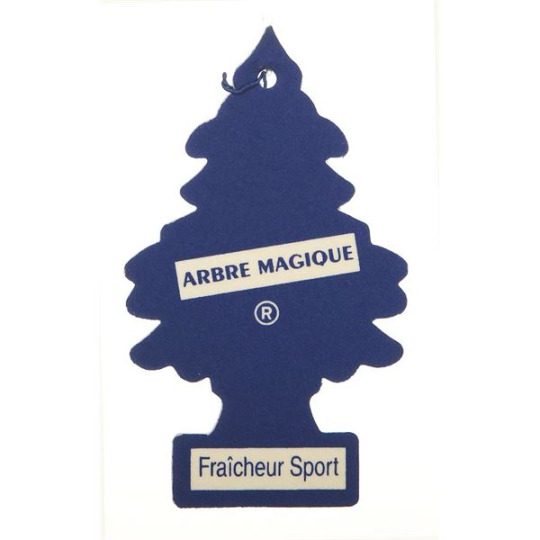
#tip of the nose#aromaphilia#answers#thatiswhy#a work in progress as i've yet to address the lutens question#will do after sleep#but as it happens i must go to bed and get a few hours of sleep in#for tomorrow morning i'm bidding on several bottles of lutens perfume
9 notes
·
View notes